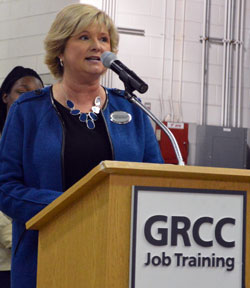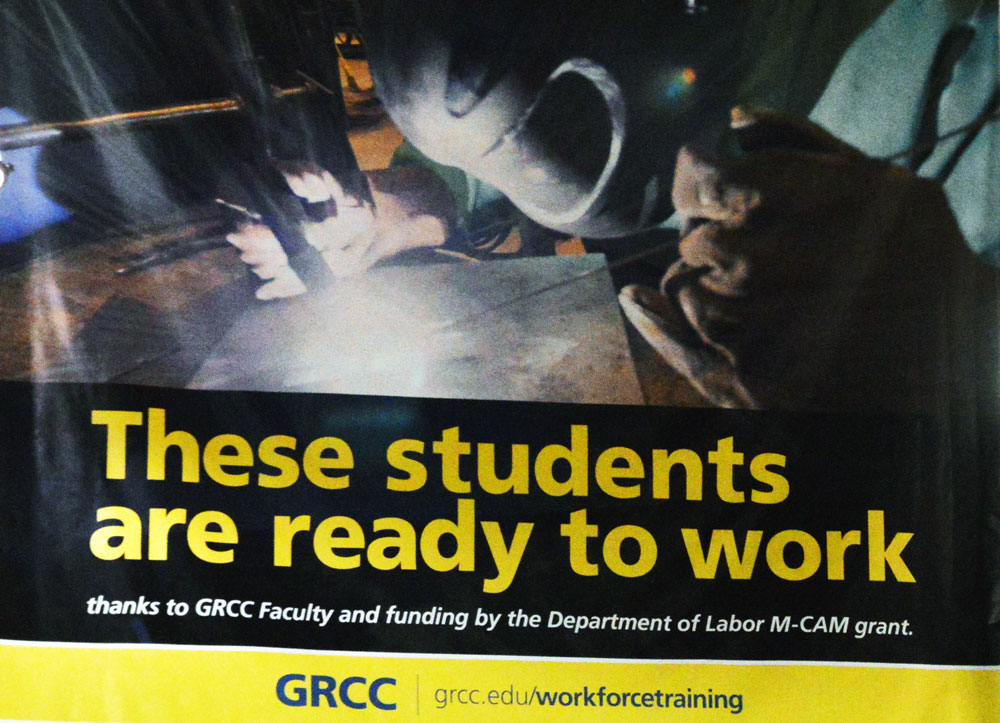A year ago, Elizabeth Jose Pena wasn’t sure what her next career step should be. “I was a lost individual… I wasn’t sure what I wanted to do with my life.”
What a difference a fast-paced training program can make. On Dec. 14, Pena will graduate from Grand Rapids Community College’s Medical Assistant Program. “This program caught my attention because I was able to work, support my family and continue my education without having to feel like I was being held back due to not making enough money,” she said.
“Here I am today… I made it. I’m one of the 3,000 families they (GRCC’s non-credit workforce programs) have helped, financially, physically and emotionally– with everything.”

Formerly a certified nursing assistant, Pena is now making $3 more per hour with scheduled pay raises.
She said GRCC helped her stick with the program, though she faced childcare needs for her three children and got married while enrolled. “I feel all the staff and faculty involved understood there would be barriers…They were always willing to help.”
GRCC educators knew its workforce training programs — which aim to equip students with career skills needed by area employers — would have a ripple effect on the local economy. Now there’s data to back it up.
The community college recently released an analysis of the economic impact of the programs, which range from healthcare to construction and manufacturing. Staff members hosted a press conference recently at the Tassell M-TEC Center, 622 Godfrey Ave. SW, where several of the programs are housed.
Hundred of millions generated
The analysis, completed by Emsi, labor market advisers to leaders in higher education, business, and community development, determined that in 2016-2017 the programs:
- Generated a $294 million economic impact in Kent and Ottawa counties from companies attracted to the region (or that expanded existing operations) in part, through GRCC training opportunities
- Affected about 3,000 jobs through these training opportunities
- Also, past and present students of GRCC non-credit programs generated $130 million in added income to the region
- Since 2014, the noncredit workforce training programs were awarded 23 grants totaling an economic impact of $16.6 million, representing new dollars brought to the GRCC service region of Kent and Ottawa counties. The grants, largely from federal government sources, will primarily be spent during the next five years
“That equates to 3,000 jobs. That’s people that have been impacted….
I think that’s the even better story,” said Amy Mansfield, dean of the school of workforce development.

GRCC President Bill Pink said the study was done as a followup to an analysis done last year, also completed by Emsi, which showed a $447 million annual economic impact in Kent and Ottawa counties from GRCC’s credit programs. When examining that report, Pink said he and other administrators believed a piece of the puzzle was missing because the non-credit workforce programs also have a huge impact, but weren’t included. Emsi worked to develop a new methodology to study the economic footprint of GRCC’s noncredit workforce programs, which they can now use in other areas.
Mansfield said GRCC staff members are always keeping a close eye on job market needs in skilled trades like welding, construction, electrical and automotive, but also healthcare partnerships. America’s Promise, a federally funded grant through the U.S. Department of Labor, has helped support GRCC’s healthcare programs.
“We have an obligation as a community college, through several different avenues, but morally, an obligation that when we prepare students, they are going to go out and be gainfully employed,” she said. “All of our programs are under that scrutiny.”
Pink said filling the area’s need with skilled workers is a continuous goal.
“We know in West Michigan that we’re not done when it comes to (meeting) talent needs. When you talk to many of our company partners they will tell you that an aging workforce continues to be an issue for them. That means the work we do in this place — in this institution– is that much more important to getting further down the road and helping to (meet) the talent needs of West Michigan.”
CONNECT
Wanted: More than a few work ready graduates










